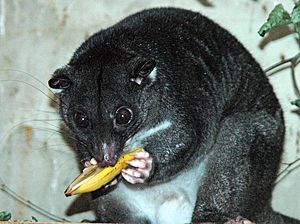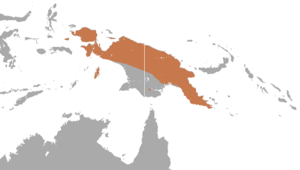Ground cuscus facts for kids
Quick facts for kids Ground cuscus |
|
|---|---|
 |
|
| Ground cuscus at Cotswold Wildlife Park | |
| Conservation status | |
| Scientific classification | |
| Genus: |
Phalanger
|
| Species: |
gymnotis
|
 |
|
| Ground cuscus range | |
The ground cuscus (Phalanger gymnotis) is a cool marsupial that lives in New Guinea and the Aru Islands. It belongs to a family called Phalangeridae. This family also includes other cuscus species and brushtail possums.
Unlike many of its relatives, the ground cuscus spends a lot of its time on the ground. But it can also climb trees very well!
Contents
Names for the Ground Cuscus
In Papua New Guinea, people who speak the Kalam language have special names for this animal. They call it madaw, ket-ketm, or kñm.
What Does a Ground Cuscus Look Like?
A ground cuscus usually weighs about 2.5 to 3.0 kilograms. That's about the same as a small dog! Its head and body are around 440 millimeters long, and its tail is about 330 millimeters long.
Cuscuses living in lowland areas are generally bigger than those in highland areas.
Special Features for Climbing
The ground cuscus has some amazing features that help it move around.
- It has opposable thumbs on its back feet. These thumbs work like ours, helping it grab branches.
- Its tail is prehensile, meaning it can grip things like a fifth limb. This helps it move easily through trees.
- The second and third toes on its front feet are split. This special design helps it climb and even hang upside down to eat.
Fur and Other Body Parts
The fur of a ground cuscus is short and thick. It's usually gray, and often has white patches on its belly.
The tail has a rough, bumpy feel at the base and on top. The underside of the tail has a ridged pattern, which helps it grip branches even better.
Its feet are large and have five toes. Only the opposable thumb on each back foot doesn't have a claw. The ears of the ground cuscus are big and don't have fur. Female cuscuses have a pouch that opens forward, and inside it, they have four mammae (milk glands) for their babies.
How Does a Ground Cuscus Behave?
Most cuscuses are arboreal, meaning they live in trees. They mainly eat leaves and fruits, and they are nocturnal, meaning they are active at night. They also tend to move slowly.
However, the ground cuscus is a bit different from other cuscuses. It often spends its days resting in burrows on the ground. It seems just as comfortable on the ground as it is in the trees. Even though some people think they mostly live in trees, wild ground cuscuses are often seen on the ground.
Social Life and Fighting
The ground cuscus is usually a solitary animal, meaning it prefers to live alone. If two ground cuscuses fight, they stand on their back legs. Then, they lash out with their front paws while making hissing and barking sounds.
Sometimes, in zoos, a male and female ground cuscus can live together. But even then, they might still have fights sometimes.
Lifespan of a Ground Cuscus
We don't know exactly how long ground cuscuses live in the wild. But in zoos, one ground cuscus lived for 18 years! It's quite common for them to live for 10 years in captivity.
Where Does the Ground Cuscus Live?
The ground cuscus is found only in New Guinea and the Aru Islands. It lives in both forests and areas with scrubland (bushes and small trees).
It is most common in places that are between 500 and 1500 meters above sea level. However, they have been seen as low as 200 meters and as high as 2600 meters. They usually avoid swampy areas, river deltas, and floodplains.
The ground cuscus is listed as "Least Concern" on the IUCN Red List. This means it's not currently in danger of disappearing. However, in some parts of its original home, it has disappeared because of too much hunting.
See also
 In Spanish: Cuscús de tierra para niños
In Spanish: Cuscús de tierra para niños


